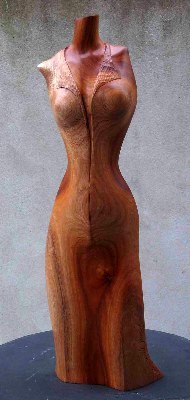
46B Weston Road Christchurch 8005 New Zealand Phone: 64 3-3559-559 Mobile: 64 025 228 4563 e-mail: DeansArt@xtra.co.nz

Moonlight Sonata, wood

Debonair, wood

Debonair (back), wood
 Eye of the Beholder, stone
Eye of the Beholder, stone |
In his book, The Soul of a Tree, George Nakashima writes, Trees have a yearning to live again, perhaps to provide the beauty, strength and utility to serve man, even to become an object of great artistic worth. In my Woodsculpture I deliberately work to fulfil that very yearning. For each piece of wood, in order to let it live again and tell its story, I access my internal, unspoken subconscious and let it show me which image to extract. This is a very personal, intuitive and satisfying process. I describe my sculpture as a gentle collaboration between the piece of wood, my self, my intuition and my friend the universe.
In the past Sculpture often re-presented a story from myth or history.
If we take the idea that trees yearn to live again, then each piece of wood has a tale to tell. It just hasn't been put into words yet.
The viewers are invited to find a personal story in each sculpture - my hope is that it will be about your own
internal, unspoken, primordial peace and joy. |
 Totara Recall, wood |
 Victory Dance, wood |
 Victory Dance, wood |
|
The Arthouse 6-25 August 2002 Paul Deans considers his approach to sculpting in wood to be a collaborative process between himself, the materials and his intuition. In Narratives Deans has used the human form as a means of investing new energy and life in timber, and to create objects of great beauty. Deans has used a variety of different types of wood in these eight sculptures, and consequently, each piece is unique in its style and character. The degree to which the natural qualities of the material have been utilized also varies greatly. In Moonlight Sonata I and Moonlight Sonata II, two portrait busts in macrocarpa and cherry respectively, the knots and grain have been exploited to express musculature and physical features. By contrast, in Debonair the form is so perfectly modelled by the pattern of grain that is appears as though the positioning and shape of the sculpture has been dictated by the natural features of the wood.
Deans’ sculptures also vary in the degree of naturalism in their execution.
Victory Dance of the Peacemaker is the most abstract of the works in this show,
but clearly embodies the artist’s intention to unleash the potential within each piece of wood to
tell its own tale. A stylised figure dances across the plinth with arms flung aloft.
Its solid, blocky form is offset by sharp angles, which exaggerates the movement and energy of the figure.
This effect of capturing the dynamism of the human body in motion is reminiscent of the Italian Futurist sculptor,
Umberto Boccioni’s Unique Forms of Continuity in Space (1913). |